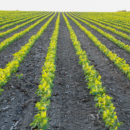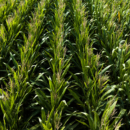FNC News
Landowner News - High Quality, High Producing Land Remains in High Demand
The first quarter of 2024 saw a decline in the volume of land sales through Farmers National Company. While such a drop tends to be typical for this time of year, values have struggled to maintain the resiliency seen in 2023.
Before 2024, land sales remained stable. While farmland is still a strong and solid asset, outside pressures like lower commodity prices and higher interest rates push profit potential down over time and lead to a softening in values.
The number one impact on land values, overall, is still commodity prices. When profit potential is cut in half, the result typically ends up being a retraction in buying power.
For example, we tracked the local cash price difference over the past year at New Cooperative in Blairsburg, Iowa. Over that one-year timespan, there was a loss of nearly $2.95/bushel on cash corn and $3.65/bushel on cash soybeans. Although prices have rebounded since then, the loss in revenue potential impacts operations.
2/19/24 | 2/20/23 | 1-Year Losses | |
Cash Corn | $4.03 | $6.98 | -$2.95 |
October Corn | $4.19 | $5.51 | -$1.32 |
Cash Soybeans | $11.17 | $14.82 | -$3.65 |
October Soybeans | $10.78 | $13.06 | -$2.28 |
The same thing goes for buyers who are highly leveraged. The interest rate pressure is slow but consistent and, over time, eats away at working capital. The gap between those with cash on hand earning 6%+ interest and those borrowing and operating at 9-10% interest widens. As interest expense increases, the impact on land values eventually will be seen. With each sale, we see fewer and fewer buyers willing to invest at the higher prices we’ve seen for the last two years.
So, what does this mean for the future? Despite these adverse effects, the high-quality, high-producing land remains in high demand. Where we have and will continue to see the most change is with recreational or lower quality land. The profit potential is less or more variable on those properties, and those farms will be impacted the most moving ahead.
As a seller, now more than ever it’s important to consult with your trusted local advisors to fully understand your farmland value and its relation to the local market. Some landowners have wondered if they should wait and sell this fall. It’s important to remember that if we do see a rally in the grain markets, and we are at more profitable levels, we should then also expect to see a greater supply of land on the market. With that in mind, the best time to sell is when you are ready, and consulting with one of our experienced agents at FNC is vital in making the best decision for you and your operation. You can reach us through our website at www.fncrealestate.com.
The first quarter of 2024 saw a decline in the volume of land sales through Farmers National Company. While such a drop tends to be typical for this time of year, values have struggled to maintain the resiliency seen in 2023.
Before 2024, land sales remained stable. While farmland is still a strong and solid asset, outside pressures like lower commodity prices and higher interest rates push profit potential down over time and lead to a softening in values.
The number one impact on land values, overall, is still commodity prices. When profit potential is cut in half, the result typically ends up being a retraction in buying power.
For example, we tracked the local cash price difference over the past year at New Cooperative in Blairsburg, Iowa. Over that one-year timespan, there was a loss of nearly $2.95/bushel on cash corn and $3.65/bushel on cash soybeans. Although prices have rebounded since then, the loss in revenue potential impacts operations.
2/19/2024 2/20/2023 1-year losses
ash Corn | $4.03 | $6.98 | -$2.95 |
October Corn | $4.19 | $5.51 | -$1.32 |
Cash Soybeans | $11.17 | $14.82 | -$3.65 |
October Soybeans | $10.78 | $13.06 | -$2.28 |
The same thing goes for buyers who are highly leveraged. The interest rate pressure is slow but consistent and, over time, eats away at working capital. The gap between those with cash on hand earning 6%+ interest and those borrowing and operating at 9-10% interest widens. As interest expense increases, the impact on land values eventually will be seen. With each sale, we see fewer and fewer buyers willing to invest at the higher prices we’ve seen for the last two years.
So, what does this mean for the future? Despite these adverse effects, the high-quality, high-producing land remains in high demand. Where we have and will continue to see the most change is with recreational or lower quality land. The profit potential is less or more variable on those properties, and those farms will be impacted the most moving ahead.
As a seller, now more than ever it’s important to consult with your trusted local advisors to fully understand your farmland value and its relation to the local market. Some landowners have wondered if they should wait and sell this fall. It’s important to remember that if we do see a rally in the grain markets, and we are at more profitable levels, we should then also expect to see a greater supply of land on the market. With that in mind, the best time to sell is when you are ready, and consulting with one of our experienced agents at FNC is vital in making the best decision for you and your operation. You can reach us through our website at www.fncrealestate.com.
More News




